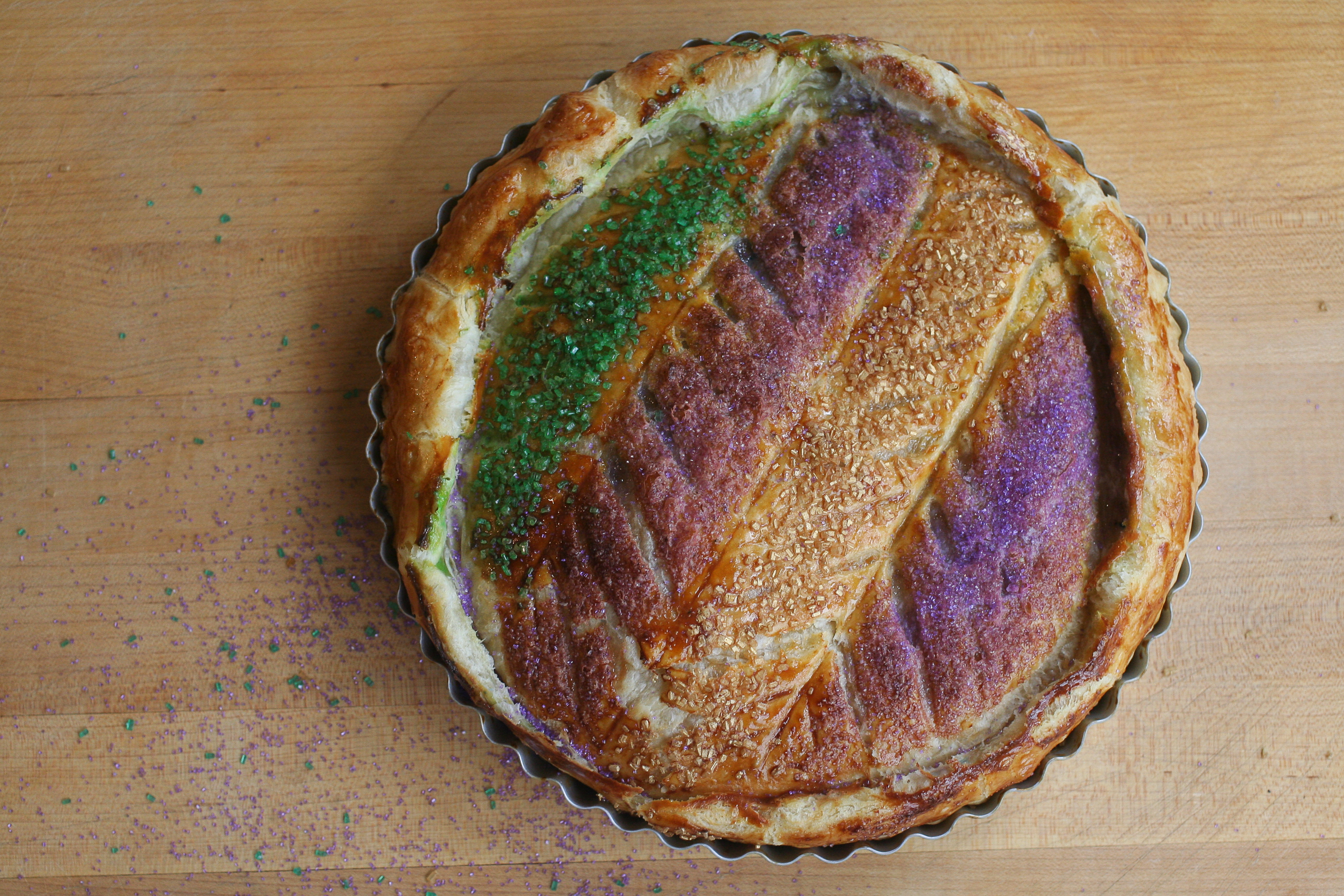
Although New Year’s Eve feels like the fizzy climax of the weeks of winter holidays, Catholics the world over have one more to celebrate: Epiphany, on January 6th. Epiphany is the day when the Three Kings, Magi or wise men–pick your favorite version–followed the star of Bethlehem to Jesus’s manger. Epiphany Eve is celebrated in many Western Christian churches as “Twelfth Night,” the festive bookend to a season that began with Halloween. Like that autumn holiday, Twelfth Night was a time when the world turned upside down: the king and nobles would become “peasants” for a night, and vice versa. (Shakespeare’s Twelfth Night was written to be performed on this night–thus its themes of multiple mistaken identities and mischievous reversals).
One of the traditional foods cooked on Twelfth Night and eaten on Epiphany, still popular in many countries, is the Kings’ Cake. In French it’s known as the Galette des Rois, in Greek the vassilopita, in Spanish the roscón de reyes. The crucial detail is that it contains a small bean or token; whoever gets the slice with the bean becomes King or Queen for the night, or has other responsibilities that vary from culture to culture (more on that later).
Americans are most familiar with the King Cake served during Mardi Gras in Louisiana. As New Yorkers, we first noticed King Cakes online: it’s pretty striking for a pastry, especially in the midst of winter gloom. New Orleans-style King Cake is a yeasted confection iced in purple, green and gold, the colors of Mardi Gras, which represent justice, faith and power. The three colors also honor the Three Kings. Louisiana King Cake is eaten during the weeks beginning on Epiphany Eve and ending with Lent.
We chose to make the French version of a Kings’ Cake, the Galette Des Rois, because it seemed like the most elegant and simplest version. In this version, the bean is replaced by a tiny ceramic or plastic toy called a fève, or favor. Sometimes it is a baby Jesus, as with the Louisiana cake, but there are many different fèves. Traditions around the favor vary from country to country–in some places, the person who finds the favor gets to play King or Queen for the night, while in others it designates the host of next year’s party or brings good luck. Feel free to create your own tradition! We went looking on Etsy and found a set of tiny china figures that was so adorable we had to order the whole thing, even if we were only going to bake with one: a nativity scene.
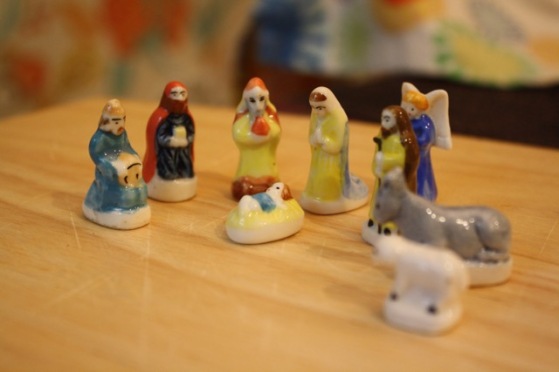
Our Galette Des Rois is basically two layers of puff pastry, sandwiching a filling made of almond meal, sugar, butter and eggs. We also decided to sprinkle ours with the traditional festive sugars, in a nod to our colorful borough. Full disclosure: we made our first attempt on a baking sheet, following the David Lebovitz recipe we were adapting –a galette is traditionally a free-form tart–and it was a disaster. The filling leaked out all over the baking sheet, producing a glorious mess that definitely wasn’t a dish to serve at a party. (That said, we ate it and it was delicious!) Our disaster is your gain: the second time around, we used a tart pan, with far prettier and equally delicious results.
Borough of Kings Cake
Ingredients:
- 1 pound of chilled puff pastry, thawed if frozen, divided into two parts
- 1 cup of almond meal or almond flour
- ½ cup sugar
- pinch of salt
- zest of a medium orange (preferably organic)
- 7 tbsp of unsalted butter, cubed and at room temperature
- 2 large eggs at room temperature
- 1 tsp rum
- ⅛ tsp almond extract
for the glaze:
- 1 egg yolk
- 1 tsp milk
optional:
- purple, green and gold decorating sugars
- ceramic or plastic favor
special equipment:
- rolling pin
- 8 or 9 inch tart pan with removable bottom
- pastry brush
1. Make the almond filling first: in a medium bowl, or in the bowl of a stand mixer with the paddle attachment, combine the almond flour, sugar, salt, and orange zest. Mix in the butter until it’s completely incorporated. Stir in the eggs one at a time, and then the rum and almond extract. Cover and chill.
2. On a lightly floured surface, roll one piece of puff pastry into a circle about 10 inches round (or slightly larger if using a 9-inch pan). Using a pot lid, plate, or bottom of springform pan as a template, trim the dough into neat circle. Fit into either an 8 or 9 inch tart pan, making sure pastry goes all the way up sides with a generous overhang. Roll the second piece of dough into a 9 inch circle, trim it, and set aside.
3. Remove the almond filling from the refrigerator. Spread the filling evenly over the center of the dough in the tart pan. Place the fève (prize) somewhere in the almond filling, if you wish. Brush water generously around the edge of overhanging dough on the bottom layer. Lay the second circle of dough over the filling and seal the edges very well, pinching them together and crimping in.
4. Chill the tart for half an hour, which will make it easier to finish and decorate. It can be refrigerated overnight at this point, if you like.
5. Preheat the oven to 375ºF (180ºC.). Use a paring knife to create a design on top–we did a crosshatch pattern. In a few places, carefully push through the dough on top to make holes for steam. Stir together the egg yolk and the milk and brush it evenly over the top. Sprinkle with decorating sugars, alternating stripes of color if you like.
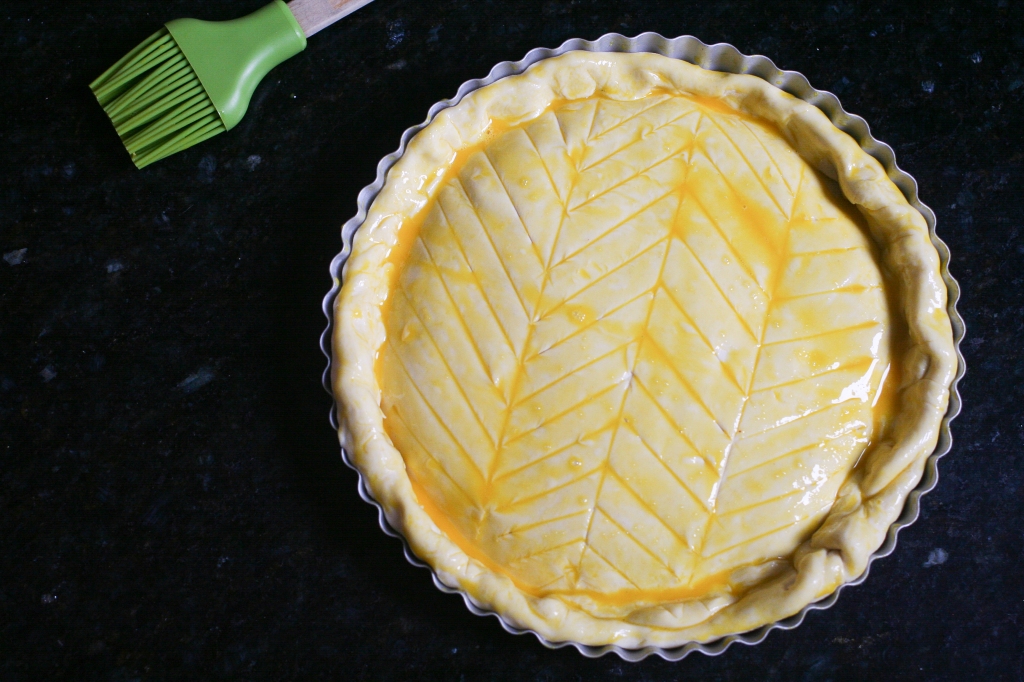
6. Bake for 30-35 minutes, or until the tart is browned on top–it may puff up a lot as it cooks. Remove from the oven and cool on a rack. The tart will deflate as it cools, which is normal. Serve warm or at room temperature.
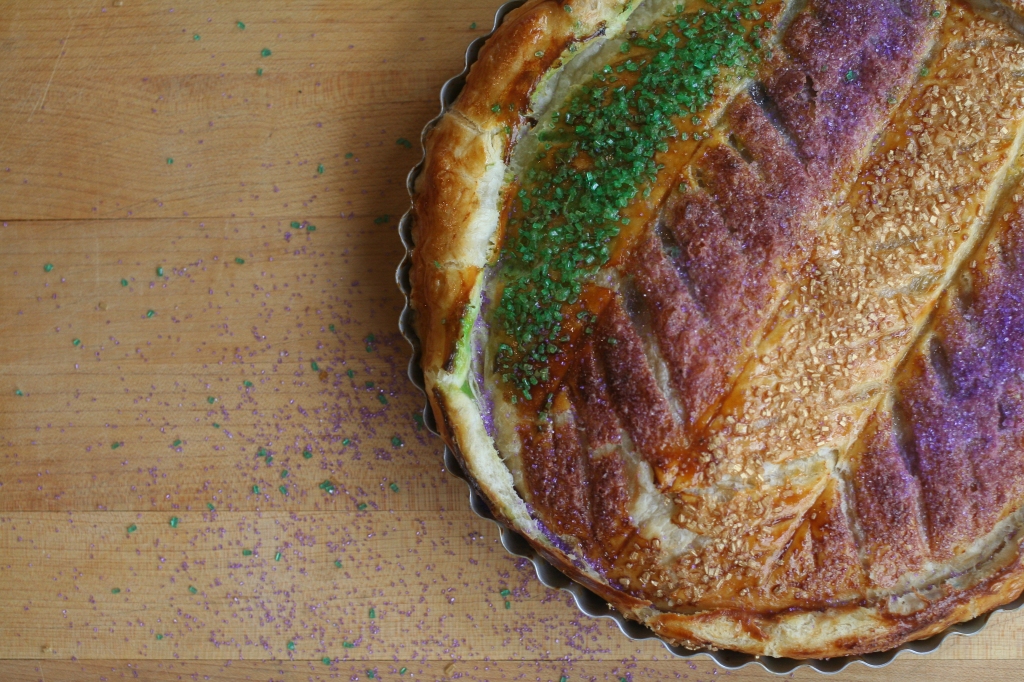
Picadillo
We couldn’t make a dessert without figuring out what meal would precede it, and we were feeling a Spanish vibe, so we chose delicious Picadillo as a main course that would feel both both festive and comforting for a chilly January night. It’s a savory chili, traditionally served in Cuba and across South America, with some mildly exotic sweet and salty notes. Serve with rice, warm tortillas or even on toasted buns as a kind of sloppy joe. Our version is adapted from the New York Times Cooking site. Zanthe left the olives whole so her daughters could avoid them if they preferred, but they’d be prettier in slices. This recipe serves four to six, though it’s easy to double if you decide to feed a crowd.
Ingredients:
- 2 tbsp olive oil
- 2 medium yellow onions, chopped
- 3 ounces dried chorizo, diced
- 4 cloves garlic, minced
- 1 ½ lbs ground beef
- 1 28 ounce can tomatoes, chopped and with liquid
- 2 tbsp red wine vinegar
- 1 tbsp ground cinnamon
- 2 tsp ground cumin
- 2 bay leaves
- pinch of ground cloves
- pinch of nutmeg
- ⅔ cup raisins
- ⅔ cup pitted stuffed olives, sliced
- salt and black pepper
1. Put the olive oil in a large, heavy pot and heat oil over medium high heat. Add onions, chorizo and garlic. Stir and cook until onions start to soften, about 5 minutes.
2. Add the ground beef, break up with a spoon and allow it to brown. Season with salt and black pepper to taste.
3. Add the tomatoes, vinegar, cinnamon, cumin, bay leaves, cloves and nutmeg. Stir to combine, lower the heat, cover and simmer for 30 minutes.
4. Now add the raisins and olives, cover and allow the stew to cook for another 15 minutes. If stew seems dry, you can add some beef or chicken broth; if it seems too fatty, you can remove some with a spoon (this will depend on the meat you use). Adjust seasonings to taste.
Serve with rice, tortillas or on toasted buns.
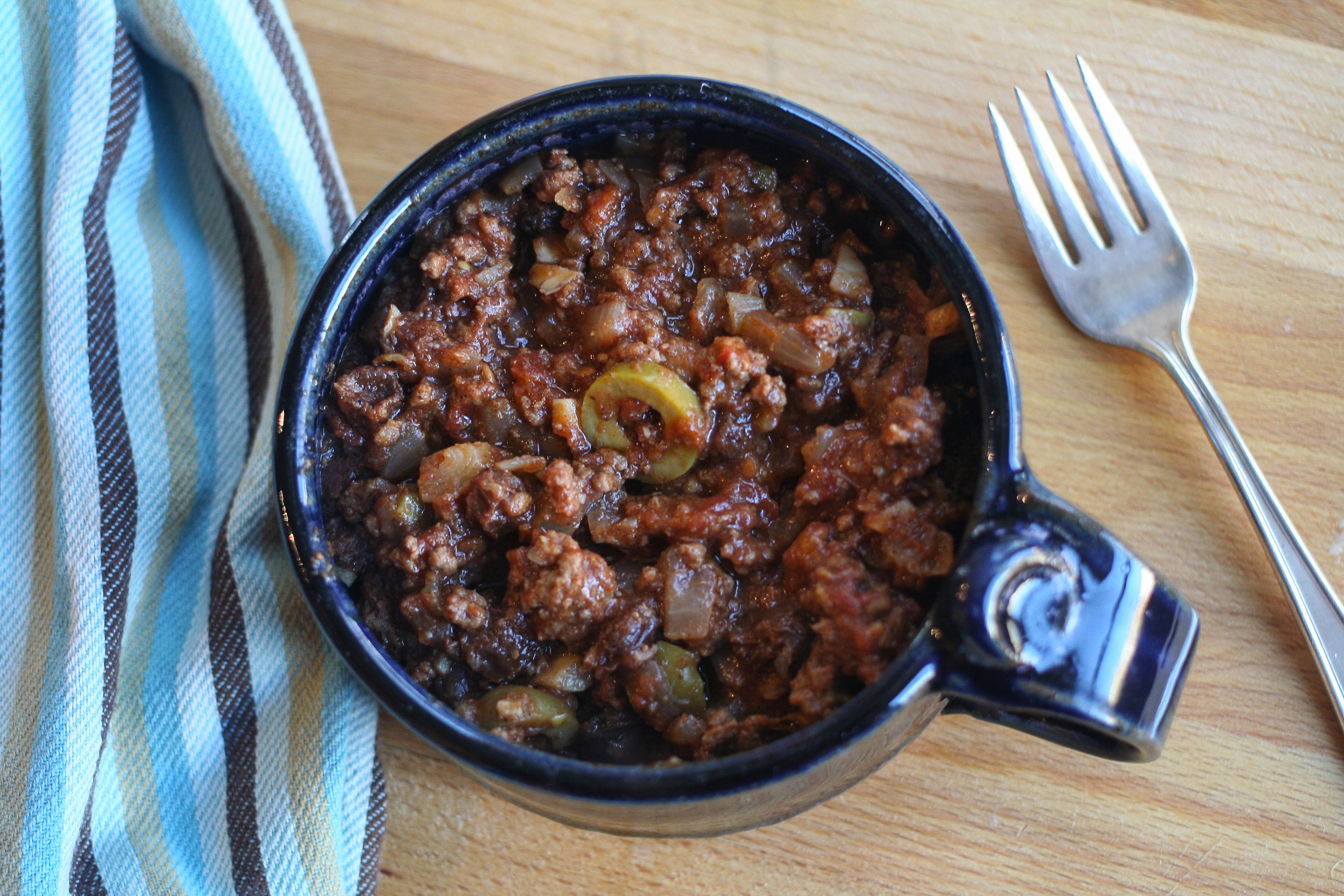

awesome!!!! nicely done
LikeLiked by 1 person
Looks Amazing!
LikeLiked by 1 person
Proud of you Both ! Keep the fabulous news letters coming ! great recipes and loving your interpretations and inputs! XOXOX
LikeLiked by 1 person
Congrats…Looking forward to more “feasts and treats”!
LikeLiked by 1 person
Terrific idea! Can”t wait to see what is next!
LikeLiked by 1 person
Terrific idea! Can”t wait to see what’s next!
LikeLiked by 1 person
Terrific idea! Can’t wait to see what’s next!
LikeLike
International variations very interesting. In the UK they still put a small coin in Christmas pudding.
And they sound delicious.
Almost enough to tempt this old man to try my hand.
LikeLiked by 1 person
Gorgeous! You have made me hungry.
LikeLiked by 1 person
We will have a late 3 Kings Day celebration and cook both!
LikeLiked by 1 person